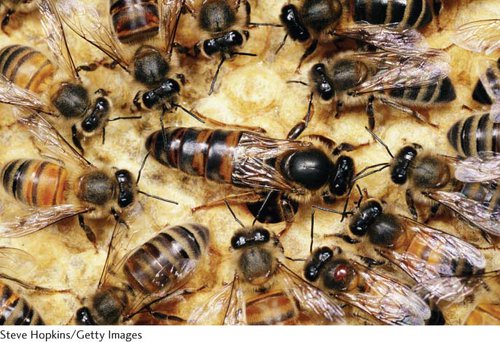15
Genomics and Proteomics
Decoding the Waggle Dance: The Genome of the Honeybee

The honeybee, Apis mellifera, is one of the world’s most amazing animals. Honeybees are highly social, living in complex colonies in which individual bees cooperate and assume responsibility for specialized tasks that benefit the entire hive. In spite of a tiny brain that contains only a million neurons (the human brain contains 100 billion neurons), bees are able to perform intricate behaviors and communicate effectively with the thousands of other bees that make up the hive. Each bee recognizes the odor of its own hive as well as odors that signal alarm, indicate tasks to be performed, and distinguish the caste, age, and sex of other bees.
Worker bees possess an extraordinary memory. On finding a clump of flowers that provides a rich supply of nectar, a worker bee returns to the hive and performs the waggle dance, in which it runs a figure eight on the side of the honeycomb. The dance conveys information to other bees about the location of the food source, including the direction in reference to the angle of the sun and the distance from the hive to the source. A bee is able to recall as many as five different flower locations, including the direction and distance of each from the hive, landmarks along the way, and the time of day when the flowers produce the most nectar.
Honeybees are not just objects of biological curiosity; they play a critical role in pollinating many important food crops, as well as providing honey and wax. Because of its agricultural and scientific importance, the honeybee was selected for sequencing by the National Genome Research Institute of the U.S. National Institutes of Health. Its complete genome sequence, which was published in 2006, has provided a wealth of information about the behavior, neural function, ecology, and evolution of honeybees. Compared with other insects, honeybees have more genes that encode olfactory receptors, which is consistent with their sophisticated chemical communication system.
The honeybee genome consists of 10,157 genes that encompass about 236 million base pairs of DNA. On the basis of the genomic information, 36 genes have been identified that encode neuropeptides, brain proteins that affect behavior and memory. More than 3000 genes are active in a bee’s brain, and researchers have located regulatory regions that control the expression of many of these genes, including some that are important in the development of foraging behavior.
The honeybee has long been associated with humans, but the precise evolutionary origin of honeybees was unknown until recently. With information from the genome sequence, honeybee geneticists used single-
European honeybees were introduced into North America by early European settlers, but some have been replaced in recent years by descendants of African “killer bees,” known for their aggressive stinging behavior. These bees were introduced into Brazil in 1956 and have subsequently spread to the southern United States. Analysis of SNPs of bees collected in the United States before 1990 showed that they possessed only European genes, but from 1993 to 2001, bees from southern Texas showed a transition to genes of predominately African ancestry.
The sequencing of the honeybee genome illustrates the diverse ways in which genomic information is being used today. Genomics is the field of genetics that attempts to understand the content, organization, function, and evolution of the genetic information contained in whole genomes. The field of genomics is at the cutting edge of modern biology; information resulting from research in this field has made significant contributions to human health, agriculture, and numerous other areas. It has provided gene sequences necessary for producing medically important proteins through recombinant DNA technology, and comparisons of genome sequences from different organisms are leading to a better understanding of evolution and the history of life.
We begin this chapter by examining genetic and physical maps and methods for sequencing entire genomes. Next, we explore functional genomics—